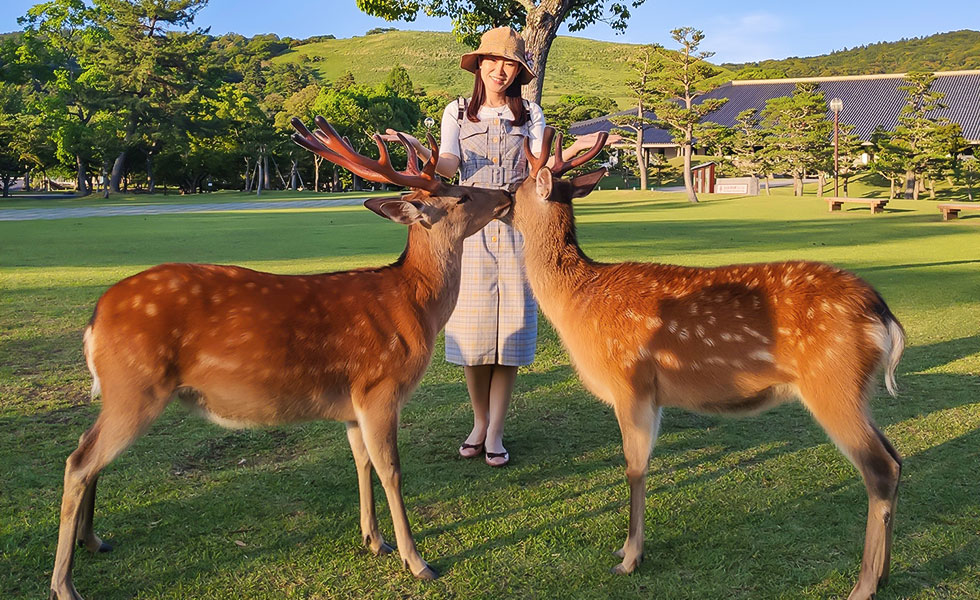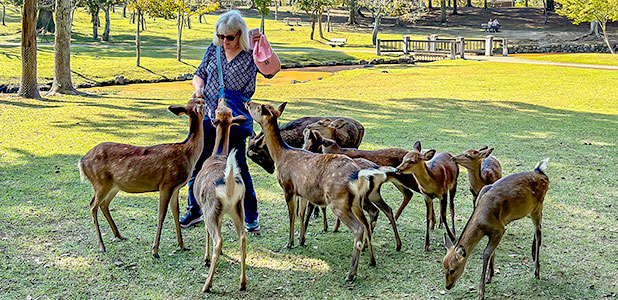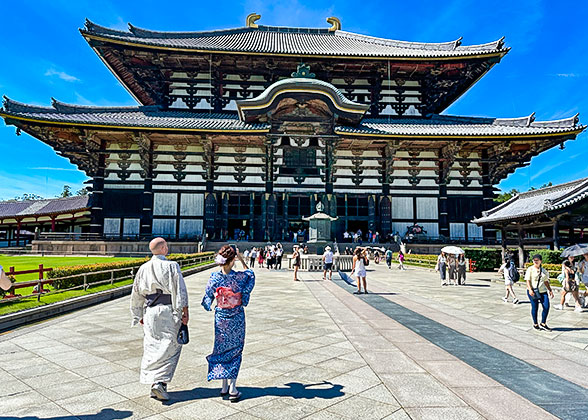Nara Attractions
Nara is the first capital in Japanese history and one of the cradles of Japanese history and culture. As the ancient city of Japan, Nara hosts abundant historical and cultural sites that are listed as World Heritage sites, like Todaiji Temple, Kasuga Taisha Shrine, and Kofukuji Temple. You can experience rich Buddhist culture and Shinto culture in Nara. Besides, the cute deer is another highlight of Nara. You can get up close and intimate with these wild deer and take pictures with them. If you plan to visit the western district of Japan, Nara should not be missed.
Top Nara Attractions to Visit
Countless tourists come to Nara just to meet cute deer, and Nara Park is the best place to touch deer. Nearly 1,300 wild deer roam here and they will bow to you for deer crackers. In the Roku-en deer center, you also can see cute fawns in June and watch the activity of sawing off the antlers in October. The cherry blossoms in April and the red leaves in October give harmonious atmosphere between nature and deer. However, do not tease deer for they may attack you. Each packet of deer crackers costs about 300 yen.

|
Todaiji Temple owns the biggest wooden structure and Bronze Buddha statue in the world and is the most notable cultural heritage in Nara. It is a must-see place in Nara. The big Buddha is stunning, and its ear is even bigger than a man, nearly 2.45 meters (8 feet) high. Beyond the big Buddha, you also can see different shapes of Buddha statues in other halls and learn about related cultures. Besides, the Great North Gate of the temple consists of many huge and stately wooden pillars, and there are two huge wooden Buddhist statues guarding it.

|
As one of the three major shrines in Japan, Kasuga Taisha Shrine is the most popular place to learn Shinto culture in Nara. The contrast between the vermilion shrine and the countless green and stately trees is stunning. Besides, nearly 3,000 stone and bronze lanterns are scattered here, decorating the old shrine. On special festivals, all lanterns will be lit, like the Setsubun Lantern Festival on February 3 and the Chugen Mantoro Lantern Festival on August 14 and 15. Besides, you can appreciate blooming flowers of more than 200 wisteria trees during April and May.

Mountain Wakakusa
|
The mountain consists of three peaks with different heights and the top of Mountain Wakakusa allows you to overlook the cityscape of Nara. The mountain is about 342 meters (1,122 feet) above sea level. In general, it takes about one hour to climb to the highest peak of the mountain. In addition, wide green grass attracts countless deer having fun on it. The mountain burning festival, known as Yamayaki, held on every fourth Saturday of January, also attracts countless visitors. During the festival, you can also enjoy the fireworks and appreciate traditional Japanese music performances.

|
Isuien Garden used to be a place where the Japanese upper class lived, so here you can observe the lifestyle of the upper class of Japan a hundred years ago. More than 20 kinds of flowers are planted in various parts of the garden, ensuring that the owner can enjoy the beautiful flowers in any season. The garden is divided into two parts, namely the front garden and the back garden. There are many tea rooms in the front garden, allowing the guests to taste the tea and have a meet. The path and pond are the features of the back garden, allowing visitors to appreciate the landscape from different angles.

|
Naramachi Koshinoie mainly refers to the Japanese traditional house, which generally has a narrow facade and a deep interior space. The house is divided into two parts, namely the front shop and the rear house. These characteristics of the Machiya were determined by the laws of Japan at the time. Since taxes in Japan were paid according to the width of a house, merchants built Machiya in order to pay less tax. If you want to enter the Machiya, you need to take off your shoes; so it is practical to take a pair of socks. Inside the Machiya, you can see the kitchen, tea room, garden, and so on.

|
In Kofukuji Temple, you can appreciate the second tallest wooden pagoda in Japan, which is about 50 meters (164 feet) high and five-storied. Besides, in the national treasures hall, rich Buddhist statues are displayed and you can learn about Buddhist culture. The Northern Round Hall and Southern Round Hall, known as the most beautiful octagonal halls, reflect the traditional Japanese architectural style. In addition, during the night, when the lights are lit up, the Kofukuji Temple shows different views.

Gangoji Temple
|
Gangoji Temple is one of the earliest Buddhist temples in Japan, and it has nearly 1,300 years’ history. After suffering fire and war, the current temple is small and does not have abundant buildings. However, the temple is quiet and peaceful, so it is a good destination to avoid crowds. Besides, there are five ogre statues inside, and you can try to find them. You also can find a miniature pagoda, about 5 meters (16 feet) high. It is said that the pagoda is the minimum building in Japan.
A large number of Buddhist-related sculptures, artifacts, paintings, and other objects are stored and displayed in Nara National Museum. Before visiting the temples in Nara, it is a good choice to visit the museum to learn about Buddhist culture. You not only can know about many interesting stories behind these national treasures, but also see the process of making Buddha statues. Besides, you can see abundant ancient Chinese bronze wares. By the way, taking pictures is forbidden inside the museum.
Goryo Shrine is a small shrine that is close to the Gangoji Shrine. In April and May, you can appreciate the cherry blossoms and peonies here. Besides, you can find a large number of red ropes tied to the feet of stone lions here, which are said to stop runaways from leaving. In addition, visitors also can pray for happy marriage and prosperous business here.
The street is close to the Kintetsu Nara Station, including varied shops, like souvenir shops, food & beverage stores, arts & crafts stores, and cosmeceuticals shops. There is a 100 yen shop, and all goods here are 100 yen. Besides, you also can find shops that sell deerskin and cartilaginous. The street also provides an arcade, ensuring visitors to go shopping on rainy days with no worries.

Himuro Shrine in Nara
|
Himuro shrine is dedicated to the Japanese god of ice and a ritual is held every year on the first weekend of May. You can taste varied shaved ice here. It is said that this is the first place in Nara where cherry blossoms bloom. In March you can enjoy the beautiful weeping cherry and there is a huge weeping cherry that is over 400 years old. It is a must-go place during the cherry blossom season. Besides, you can request for fortune-telling sticks and put them on the ice to see the contents of the sticks.

Toshodaiji Temple
|
It was built in 759 by a famous Chinese monk, Jianzhen, who had a profound impact on Buddhist culture in Japan. The statue of Buddha Avalokitesvara with 42 big hands and 911 small hands is the must-see national treasure here. Besides, you also can see other cherished Buddhist statues, like the statue of Jianzhen monk. Autumn is a good time to visit the temple when it is beautifully decorated by red leaves. The temple is relatively quiet than other temples in Nara Park, and you can see more Japanese visitors here.

Horyuji Temple in Autumn
|
Established in 607, it is the oldest wooden structure in the world, and the first place listed as a World Cultural Heritage site in Japan. The temple is divided into two main districts, namely the western district and the eastern district. Western district hosts the oldest wooden buildings complex in the world, like central gate, a five-storey pagoda, and golden hall. Hall of Dreams is the main building in the eastern district. More than 2,500 important historical and cultural properties and buildings are preserved here.
More Attractions to Visit in Nara
1. Heijo Palace Museum was once the place where the emperors lived. The four sides of the palace are surrounded by about 5 meters (16 feet) high walls. The palace hosts a total of 12 gates, and the central gate in the south is Suzaku Gate. More than 50,000 pieces of carpentry, pottery, tiles, utensils, and other cultural relics have been unearthed here.
2. Futaiji Temple is the emperors’ retreat after abdication. You can see Camellia flowers from November to May.
3. Kairyuoji Temple, also known as Sumidera Temple, is a good place to appreciate Thundberg's meadowsweet flowers during April and May.
4. Saidaiji Temple was built in the west of the Nara. The temple holds the Ochamori Tea Ceremony three times a year, and people use a big bowl about 30cm (11 inch) in diameter to drink green tea.
 Read more: Nara Photos & Nara Videos
Read more: Nara Photos & Nara Videos














![]() Read more: Nara Photos & Nara Videos
Read more: Nara Photos & Nara Videos





